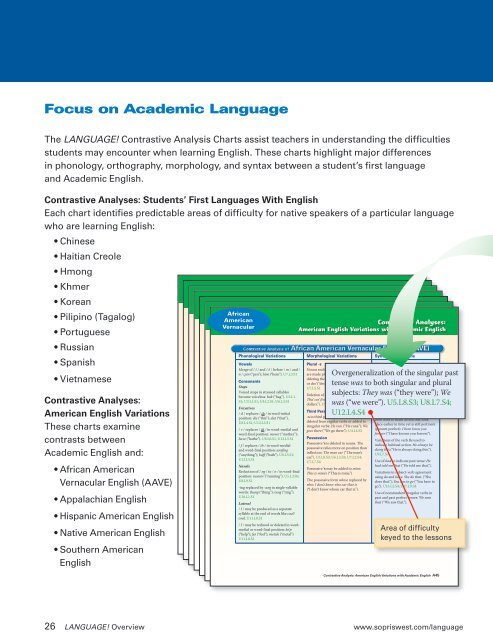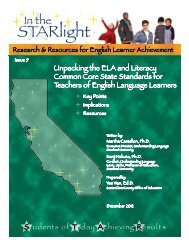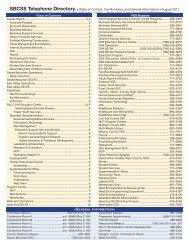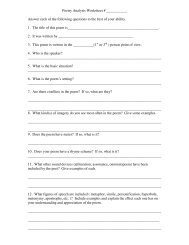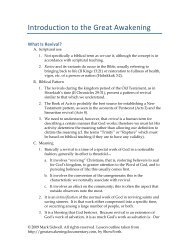4th Edition LANGUAGE! Overview
4th Edition LANGUAGE! Overview
4th Edition LANGUAGE! Overview
Create successful ePaper yourself
Turn your PDF publications into a flip-book with our unique Google optimized e-Paper software.
Focus on Academic LanguageThe <strong>LANGUAGE</strong>! Contrastive Analysis Charts assist teachers in understanding the difficultiesstudents may encounter when learning English. These charts highlight major differencesin phonology, orthography, morphology, and syntax between a student’s first languageand Academic English.Contrastive Analyses: Students’ First Languages With EnglishEach chart identifies predictable areas of difficulty for native speakers of a particular languagewho are learning English:• Chinese• Haitian Creole• Hmong• KhmerContrastive Analyses:American English Variations with Contrastive Academic Analyses: English• KoreanAmerican English Variations with Contrastive Academic Analyses: EnglishAmerican English Variations with Contrastive Academic Analyses: EnglishAfricanAmerican English Variations with Contrastive Academic Analyses: English• Pilipino (Tagalog)American English Variations with Contrastive Academic Analyses:AmericanEnglishPhonological Variations Morphological American Variations English Syntactic Variations Variations with Contrastive Academic Analyses: EnglishPhonological Vernacular Variations Morphological American Variations English Syntactic Variations Variations with Academic English• PortugueseVowelsPlural -sOvergeneralization of the singular pastPhonological Variations Morphological Variations Syntactic VariationsMerge Vowels of / ĭ / and / ĕ / before / m / and / Nouns Plural ending -s in voiceless consonants tense Overgeneralization was to both singular of the and singular plural pastPhonological Variations Morphological Variationsn /: pin (“pen”); him (“hem”). U7.L3.S1 are made plural by adding / ĭz / or by subjects: They Syntactic was (“they VariationsMerge Vowels of / ĭ / and / ĕ / before / m / and / Nouns Plural ending -s in voiceless consonants tense Overgeneralization was to both singular were”); of the and singular We plural pastPhonological Variationsdeleting the final Morphological consonant: desez Variations• Russiann /: pin (“pen”); him (“hem”). U7.L3.S1 are made plural by adding / ĭz / or by was subjects: (“we were”). They Syntactic U5.L8.S3; was (“they VariationsU8.L7.S4;Consonants Merge Vowels of / ĭ / and / ĕ / before / m / and / Nouns Plural ending -s in voiceless consonants tense Overgeneralization was to both singular were”); of the and singular We plural pastPhonological or des’ deleting (“desks”); the final tesez Morphological consonant: tes’ (“tests”) desez Variations U12.L4.S4n /: pin (“pen”); him (“hem”). U7.L3.S1 are made plural by adding / ĭz / or by was subjects: (“we were”). They Syntactic U5.L8.S3; was (“they U8.L7.S4;Stops Consonants Merge Vowels of / ĭ / and / ĕ / before / m / and / Nouns Plural ending -s in voiceless consonants tense Overgeneralization was to both singular were”); of the and singular We plural pastPhonological Variations Morphological Phonological U7.L5.S1 or des’ (“desks”); tesez tes’ (“tests”) Deletion U12.L4.S4n /: pin (“pen”); him Variations deleting the final Morphological(“hem”). U7.L3.S1 are made plural consonant: by adding desez / Syntactic Variations was of (“we a form were”). of be U5.L8.S3; in the present U8.L7.S4;Voiced Stops Consonantsstops in Merge stressed of / syllables ĭ / and / ĕ / before / m / and / Nouns ending in voiceless ĭz consonants / or by subjects: tense They was VariationsSyntactic was (“they VowelsPlural -sOvergeneralization to both singular were”); of the and singular We plural past• SpanishDeletion U7.L5.S1 or of des’ -s(“desks”); “nouns tesez of measure” or tes’ (“tests”) progressive occurs where Academicbecome voiceless: bak (“bag”). U2.L1.Deletion U12.L4.S4n /: deleting the final consonant: desez was of (“we a form were”). of be U5.L8.S3; in the present U8.L7.S4;Voiced Stops Consonantsstops in Merge pinstressed Vowels (“pen”); of / syllables ĭ him / and (“hem”). / ĕ / before U7.L3.S1 / m / and / are Nouns made Plural plural ending -sby in adding voiceless / ĭz consonants / or by subjects: tense Overgeneralization They was to was both (“they singular were”); of the and singular We plural pastTha’ cos’ five dolla’ (“That costs five English uses contractions: I startin’ theS1; become U3.L1.S1; voiceless: U4.L2.S1; bak U6.L3.S1Deletion U7.L5.S1 or of des’ -s(“desks”); “nouns tesez of measure” or tes’ (“tests”) progressive(“bag”). U2.L1.Deletion U12.L4.S4n /: deleting the final consonant: desez was occurs of (“we a form where were”). of be Academic U5.L8.S3; the present U8.L7.S4;Voiced Stops Consonantsstops in Merge pin (“pen”);stressed of / syllables ĭ him / and (“hem”). / ĕ / before U7.L3.S1 / m / and / are Nouns made plural ending by in adding voiceless / ĭz consonants / or by subjects: tense They was to was both (“they singular were”); and We pluraldollars.”). U9.L5.S3car. (“I’m starting the car.”); She eatin’VowelsPluralFricatives S1; -sTha’U3.L1.S1; U4.L2.S1; U6.L3.S1Deletion cos’ U7.L5.S1 five or of des’ dolla’ -s(“desks”); (“That “nouns costs tesez of measure” five or tes’ (“tests”) English progressive uses contractions: I startin’ thebecome voiceless: bak (“bag”). U2.L1.Deletion U12.L4.S4n /: pin (“pen”); him (“hem”). U7.L3.S1 deleting are made the final plural consonant: by Overgeneralization adding desez / ĭz / or by was occurs of (“we a form where were”). of be Academic U5.L8.S3; of the present U8.L7.S4; singular pastVoiced Stops Consonantsstops in stressed syllables dollars.”). U9.L5.S3rice car. (“She’s (“I’m eating starting rice.”). U5.L8.S3;• Vietnamesesubjects: the car.”); They She eatin’was (“they were”); WeThird Person Tha’ -s/ d / Fricatives replaces S1; U3.L1.S1; / th / U4.L2.S1; word-initial U6.L3.S1Deletion cos’ U7.L5.S1 five or of des’ dolla’ deleting -s(“desks”); (“That “nouns the final costs tesez of measure” consonant: five or tes’ (“tests”) desez English progressive uses contractions: I startin’ thebecome voiceless: bak (“bag”). U2.L1.Deletion U12.L4.S4 was occurs of (“we a form where were”). of be Academic U5.L8.S3; the present U8.L7.S4;Voiced Stops Consonantsstops stressed syllablesU9.L3.S4; rice (“She’s U12.L4.S4dollars.”). eating rice.”). U5.L8.S3;position: dis (“this”); dat (“that”). -s in Third third Person Tha’ U9.L5.S3car. (“I’m starting the car.”); She eatin’person singular -s may be/ d / Fricatives replaces S1; U3.L1.S1; / / in U4.L2.S1; word-initial U6.L3.S1Deletion cos’ U7.L5.S1 five or of des’ dolla’ -s(“desks”); in (“That “nouns costs tesez of measure” five or tes’ (“tests”) English progressive uses contractions: I startin’ thebecome voiceless: bak (“bag”). U2.L1.Deletion U12.L4.S4Merge of / ĭ / and / ĕ / before / m / and / Nouns endingoccurs where AcademicVoicedin of a form of be the presentStopsstops stressed syllablesconsonants tense was to both singular and pluralU8.L4.S1; U12.L3.S1deleted from regular verbs or added toBeen U9.L3.S4; used to mark U12.L4.S4dollars.”). rice (“She’s eating action rice.”). that took U5.L8.S3;position: dis (“this”); dat (“that”). -s in Third third Person Tha’ U9.L5.S3car. (“I’m starting the car.”); She eatin’person singular -s may be/ d / Fricatives replaces S1; U3.L1.S1; / / in U4.L2.S1; word-initial U6.L3.S1Deletion cos’ U7.L5.S1 five of dolla’ -s in (“That “nouns costs of measure” five English progressive uses contractions: I startin’ thebecome voiceless: bak (“bag”). U2.L1.Deletion occurs of a form where of be Academicthe presentVoiced stops stressed syllablesirregular verbs: He run. (“He runs.”); Weplace earlier in time yet is still pertinent/ v / U8.L4.S1; replaces U12.L3.S1deleted from regular verbs or added toBeen U9.L3.S4; used to mark U12.L4.S4dollars.”). U9.L5.S3rice car. (“She’s (“I’m eating action starting rice.”). that the took U5.L8.S3; car.”); She eatin’n /: pin (“pen”); him (“hem”). U7.L3.S1 are madeposition:pluralth dis / in (“this”); word-medial dat (“that”). -s in Third third Person Tha’ person cos’ singular -s five dolla’ may (“That be costs five English uses contractions: I startin’ the/ d / Fricatives replaces S1; become U3.L1.S1; by adding/ / in voiceless: U4.L2.S1; word-initial and bak U6.L3.S1 (“bag”)./ ĭzU2.L1./ or by Deletion of -s in subjects: “nouns of measure” They progressive was occurs (“they where Academic were”); Wegoes there (“We go there.”). U4.L4.S3(present perfect): I been know youirregular verbs: He run. (“He runs.”); Weplace earlier in time yet is still pertinentContrastive Analyses:word-final / v / U8.L4.S1; replaces U12.L3.S1deleted from regular verbs or added toBeen U9.L3.S4; used to mark U12.L4.S4dollars.”). rice (“She’s eating action rice.”). that took U5.L8.S3;position: th dis mover / (“this”); word-medial (“mother”); dat (“that”). -s in Third third Person Tha’ person cos’ U9.L5.S3singular -s five dolla’ may (“That be costs five car. English (“I’m starting uses contractions: the car.”); She I startin’ eatin’ the/ d / Fricatives replaces S1; U3.L1.S1; / / in U4.L2.S1; word-initial and U6.L3.S1forever (“I have known you forever.”).goes there (“We go there.”). U4.L4.S3(present perfect): I been know youbave word-final (“bathe”). U8.L6.S1; mover U12.L5.S1 (“mother”);Possession irregular verbs: He run. (“He runs.”); Weplace earlier in time yet is still pertinent/ v / U8.L4.S1; replaces U12.L3.S1deleted from regular verbs or added toBeen U9.L3.S4; used rice to (“She’s mark U12.L4.S4 eating action rice.”). that tookdeleting the final consonant: desez dollars.”). U9.L5.S3 was (“we were”). U5.L8.S3; U8.L7.S4;position: th dis / in (“this”); word-medial dat (“that”). -s in Third third Person person singular -s may beandVariations forever of (“I the have verb known car. (“I’m Be used you to forever.”).starting the car.”); She eatin’/ d / Fricatives replaces / / in word-initial goes there (“We go there.”). U4.L4.S3(present perfect): I been know youPossessive ’s is in nouns. TheAmerican English Variations/ f / bave replaces word-final (“bathe”). / / in U8.L6.S1; word-medial mover U12.L5.S1 (“mother”);Possession irregular verbs: He run. (“He runs.”); Weplace earlier in time yet is still pertinent/ v / U8.L4.S1; replaces U12.L3.S1deleted from regular verbs or added toBeen U9.L3.S4; used rice to (“She’s mark U12.L4.S4 eating action rice.”). that took U5.L8.S3;Consonantsposition: th dis / in (“this”); word-medial dat (“that”). -s in Third third Person person singular -s mayandindicate be/ d / replaces / / in word-initialVariations forever habitual of (“I the action. have verb known He Be always used you to forever.”). bepossessive goes relies there more (“We on position go there.”). than U4.L4.S3(present perfect): I been know youand / word-final f / bave replaces word-final (“bathe”). position: / / in U8.L6.S1; word-medialanyfing mover U12.L5.S1 (“mother”);Possessive Possession irregular ’s is verbs: in nouns. He run. The (“He runs.”); Weplace earlier in time yet is still pertinent/ v / U8.L4.S1; replaces / U12.L3.S1deleted from regular verbs doing or addedindicate this toBeen U9.L3.S4; used to mark U12.L4.S4or des’ (“desks”); tesez or tes’ (“tests”) U12.L4.S4action that tookposition: th dis / in (“this”); word-medial dat (“that”). -s in third person singular may be (“He habitual is always action. doing He this.”). always beinflection:andThe man car (“The man’sVariations forever of (“I the have verb known Be used you to forever.”).(“anything”); and word-final baff (“bath”). position: U8.L5.S1;possessive goes relies there more (“We on position go there.”). than U4.L4.S3(present perfect): I been know youanyfingPossessive ’s is in nouns. The U9.L7.S4/ f / bave replaces (“bathe”). / / in U8.L6.S1; word-medial U12.L5.S1 Possession irregular verbs: He run. (“He runs.”); Weplace earlier in time yet is still pertinentword-final / v / U8.L4.S1; replaces position: / U12.L3.S1deleted from regular verbs doing or added this toBeen used to mark action that tookStopsmover (“mother”);(“He is always doing this.”).car.”). U3.L8.S3; U6.L5.S3; U7.L2.S4;indicate habitual action. He always beThese charts examineU12.L5.S1inflection: The man car (“The man’sVariations forever of (“I the have verb known Be used you to forever.”).U7.L5.S1th / in word-medial and(“anything”); and word-final baff (“bath”). position: U8.L5.S1;possessive goes relies there more (“We on position go there.”). than U4.L4.S3(present perfect): I been know youanyfingPossessive ’s is deleted in nouns. TheU7.L7.S4 car.”). U3.L8.S3; U6.L5.S3; U7.L2.S4;Use U9.L7.S4/ f / bave replaces (“bathe”). / / in U8.L6.S1; word-medial U12.L5.S1 Possession irregular verbs: He run. (“He runs.”); Weplace earlier in time yet is still pertinentword-final / v / replaces position: / th mover / in word-medial (“mother”);of had doing indicate to this indicate (“He habitual is past always tense: action. doing He He this.”). always beNasals U12.L5.S1inflection:andDeletion ofThe man car (“The man’sVariations forever aof (“I the have verb known Be used you to forever.”).(“anything”); and word-final baff (“bath”). position: U8.L5.S1;possessive goes relies there more (“We on position go there.”).anyfinghadthan U4.L4.S3(present form perfect): of I been in know the you presentVoiced stops in stressed syllablestold me that (“He told me that.”).Possessive U7.L7.S4 car.”).Use U9.L7.S4/ f / bave replaces word-final (“bathe”). / / position: in U8.L6.S1; word-medial mover U12.L5.S1 (“mother”);Possessive Possession ’s is deleted in nouns. Theof had doing to this indicate (“He is past always tense: doing He this.”).’s may U3.L8.S3; be added U6.L5.S3; to mine: U7.L2.S4;indicateReduction Nasals U12.L5.S1inflection: The man car (“The man’sVariations forever habitual of (“I the action. have verb known He Be always used you to forever.”). be(“anything”); of / and ng word-final to / n baff / (“bath”). word-final position: U8.L5.S1; anyfingcontrasts betweenDeletion of -spossessive relies more on positionThis Possessive is U7.L7.S4 mine’s (“This ’s may is be mine.”) added to mine:Variations hadthanUse told U9.L7.S4/ in f / replaces “nouns / / word-medial of measure”bave (“bathe”). U8.L6.S1; U12.L5.S1 Possessive Possession ’s is deleted progressive in nouns. Thein of me subject-verb had doing that to (“He indicate told agreement past that.”).car.”). U3.L8.S3; U6.L5.S3; U7.L2.S4;indicateoccurs this (“He habitual is always wheretense: action. doing He He this.”). alwaysAcademicposition: Reduction Nasals runnin’ U12.L5.S1inflection: The man car (“The man’sVariations of the verb Be used to bebecome voiceless: bak (“bag”). U2.L1.(“anything”); of /(“running”). ng to / n baff / U5.L3.S6;(“bath”). word-final U8.L5.S1;possessiveand word-final position: anyfingPossessive relies ’s is more deleted on position inusingnouns.do and have. She do that. (“SheU8.L9.S1 position: runnin’ (“running”). U5.L3.S6;The This possessive Possessive is U7.L7.S4 mine’s form (“This ’s may whose is be mine.”)Variations hadthan TheUse told U9.L7.S4/ f / replaces / / word-medialin of me subject-verb had doing that to (“He indicate told agreement past that.”).car.”). U3.L8.S3;tense: Hereplaced added U6.L5.S3; to by mine: U7.L2.S4;indicate this (“He habitual is always action. doing He this.”). always beTha’ cos’ five Reduction Nasals U12.L5.S1 dolla’inflection: The man car (“The man’s(“anything”); of / and ng / word-final to /(“That n baff / (“bath”). word-final position: U8.L5.S1; costs anyfing five possessive relies English more ondoesposition usesusing that.”); do You and has have. to She go (“You do that. have (“She towho: I don’t know who car that isAcademic English and:-ing U8.L9.S1The This possessive Possessive is U7.L7.S4 mine’s form (“This ’s may whose is be mine.”)Variations hadthanUse told U9.L7.S4 contractions: I startin’ thein of me subject-verb had doing that to this (“He indicate (“He told agreement is past always that.”). tense: doing He this.”).S1; U3.L1.S1; U4.L2.S1; U6.L3.S1car.”). replaced added to by mine:replaced position: Reduction by Nasals runnin’ -ang U12.L5.S1inflection: U3.L8.S3; The U6.L5.S3; man U7.L2.S4;of /(“running”). single-syllable/ to / n / U5.L3.S6; in word-finalgo.”).(“Thedoes U15.L5.S4;man’s(“anything”); baff (“bath”). U8.L5.S1;that.”); You U17.L9.S4 has to go (“You have to(“I don’t who: know I don’t whose know who that car is.”).using do and have. She do that. (“Shethat iswords: -ing U8.L9.S1 thang replaced position: (“thing”); by runnin’ -ang rang (“running”). single-syllable(“ring”). U5.L3.S6;The This possessive Possessive is U7.L7.S4 mine’s form (“This ’s may whose be mine.”)Variations had Use told U9.L7.S4of me subject-verb had that to (“He indicate told agreement past that.”). tense: Hedollars.”). U9.L5.S3car.”). U3.L8.S3; replaced added U6.L5.S3; car. to by mine: (“I’m U7.L2.S4; starting the car.”); She eatin’Reduction Nasals U12.L5.S1 of / / to / n / in word-final(“I don’t know whose car that is.”).Use go.”). of nonstandard does U15.L5.S4; using that.”); do You and irregular U17.L9.S4 has have. to verbs She go (“You do that. have (“She toU10.L1.S1who: I don’t know who car that iswords: -ing U8.L9.S1 thang replaced position: (“thing”); by runnin’ -ang rang (“running”). single-syllable(“ring”). U5.L3.S6;The This possessive Possessive is U7.L7.S4 mine’s form (“This ’s may whose be mine.”)Variations had Use told of me subject-verb had that to (“He indicate told agreement past that.”). tense: Hereplaced added topastby mine:Reduction of / / to / n / in word-finalUse and go.”). of past nonstandard does U15.L5.S4; perfect that.”); tenses: You irregular U17.L9.S4FricativesNasalshas We to seen(“I don’t know whose car that is.”).using do and have. verbs She go (“You do in that. have (“She to• African AmericanLateral U10.L1.S1who: I don’t know who car that iswords: -ing U8.L9.S1 thang replaced position: (“thing”); by runnin’ -ang rang (“running”). single-syllable(“ring”). U5.L3.S6;The This possessive Possessive is mine’s form (“This ’s may ricewhose be mine.”)Variations subject-verb agreementreplaced added (“She’sthattopast (“We by mine: eatinghad told merice.”).that (“He toldU5.L8.S3;that.”).Reduction of / / to / n / in word-finalUse and saw go.”). of past nonstandard does that.”). U15.L5.S4; perfect that.”); tenses: You irregular U17.L9.S4 has We to seen(“I don’t know whose car that is.”).using do and have. verbs She go (“You do in that. have (“She to/ l / Lateral may U10.L1.S1who: I don’t know who car that isbe words: produced -ing U8.L9.S1 thang replaced as (“thing”); a separate by -ang rang single-syllable(“ring”).The This possessive is mine’s form (“Thisposition: runnin’ (“running”). U5.L3.S6;whose mine.”)Variations in subject-verb agreementThird Person -sreplaced that past (“We byUse and saw go.”). of past nonstandard does that.”). U15.L5.S4; perfect that.”); tenses: You irregular U17.L9.S4 has We to seen(“I don’t know whose car that is.”).verbs go (“You in have to/ d / replaces / th / in word-initialU9.L3.S4; U12.L4.S4using do and have. She do that. (“Shesyllable / l / Lateral may the U10.L1.S1who: I don’t know who car that isbe words: end produced -ing of words U8.L9.S1 thang replaced as (“thing”); like a separate by cool/ -ang rang single-syllable(“ring”).The possessive form whose replaced that past (“We byUse and saw go.”). of past nonstandard does that.”). U15.L5.S4; perfect that.”); tenses: You irregular U17.L9.S4 has We to seen verbs go (“You in have toVernacular English (AAVE)(“I don’t know whose car that is.”).coal. syllable U11.L8.S1 / l / Lateral may the U10.L1.S1who: I don’t know who car that isbe words: end produced -ing of words thang replaced as (“thing”); like a separate by cool/ -ang rang in single-syllable(“ring”).that past (“We Use and saw go.”). of past nonstandard that.”). U15.L5.S4; perfect tenses: irregular U17.L9.S4position: dis (“this”); dat (“that”). -s in third person singular may beWe seen(“I don’t know whose car that is.”).verbs in/ l / coal. may syllable U11.L8.S1 be / reduced l / Lateral may the U10.L1.S1 be words: end produced deleted of words thang in as wordmedial/ l / coal. or may word-final syllable U11.L8.S1 be / reduced l / Lateral may the U10.L1.S1 position: be or end produced deleted of he’p words in as word-like a separate cool/that (“We saw that.”).(“thing”); like a separate cool/ rang (“ring”).that past (“We Use and saw of past nonstandard that.”). perfect tenses: irregular We seen verbs inU8.L4.S1; • Appalachian U12.L3.S1deleted from regular verbs or added toBeen used to mark action that tookpast and past perfect tenses: We seenEnglish(“help”); medial / l feә / coal. or may (“feel”); word-final syllable U11.L8.S1 be / reduced l metuh / Lateral may the position: be (“metal”) or end produced deleted of he’p words in as wordmedial/ l feә / coal. or may (“feel”); word-final syllable U11.L8.S1 be / reduced l metuh / may at the position: be (“metal”) or end produced deleted of he’p words in as word-like a separate cool/like a separate cool/that (“We saw that.”).irregularU11.L8.S1verbs: He run. (“He runs.”); Weplace earlier in time yet is still pertinent(“help”);/ v / replaces / th / in word-medial andU11.L8.S1 (“help”); medial / l feә / coal. or may (“feel”); word-final syllable U11.L8.S1 be reduced metuh at position: (“metal”) or end deleted of he’p words in wordmedial/ l feә / coal. or may (“feel”); word-final U11.L8.S1 be reduced metuh position: (“metal”) or deleted he’p in word-like cool/• Hispanic American English goes there (“We go there.”). U4.L4.S3(present perfect): I been know youU11.L8.S1 (“help”);word-final position: mover (“mother”);U11.L8.S1forever (“I have known you forever.”).(“help”); medial / l feә / or may (“feel”); word-final be reduced metuh position: (“metal”) or deleted he’p in wordmedialfeә or (“feel”); word-final metuh position: (“metal”) he’pU11.L8.S1 (“help”);bave • Native (“bathe”). American U8.L6.S1; U12.L5.S1 PossessionArea of difficultyEnglishU11.L8.S1 (“help”); feә (“feel”); metuh (“metal”)Variations of theU11.L8.S1Possessive ’s is deleted in nouns.ContrastiveThekeyedverbtoBetheusedlessonstoAnalysis: American English Variations with Academic English A45/ f / replaces / th / in word-medialindicate habitual action. He always be• Southern Americanand word-final position: anyfing(“anything”); English baff (“bath”). U8.L5.S1;U12.L5.S1Contrastive Analyses:American English Variations with Academic Englishpossessive relies more on position thaninflection: The man car (“The man’scar.”). U3.L8.S3; U6.L5.S3; U7.L2.S4;U7.L7.S4Contrastive Analysis: American English Variations with Academic English A45Contrastive Analysis: American English Variations with Academic English A45Contrastive Analysis: American English Variations with Academic English A45Contrastive Analysis: U9.L7.S4American English Variations with Academic English A45Contrastive Analysis: American English Variations with Academic English A45Contrastive Analysis: American English Variations with Academic English A45doing this (“He is always doing this.”).Use of had to indicate past tense: Hehad told me that (“He told me that.”).NasalsPossessive ’s may be added to mine:Reduction of / ng / to / n / in word-finalThis is mine’s (“This is mine.”)Variations in subject-verb agreementposition: runnin’ (“running”). U5.L3.S6;using do and have. She do that. (“SheU8.L9.S1The possessive form whose replaced bydoes that.”); You has to go (“You have to26 <strong>LANGUAGE</strong>! <strong>Overview</strong> who: I don’t know who car that iswww.sopriswest.com/language-ing replaced by -ang in single-syllablego.”). U15.L5.S4; U17.L9.S4


